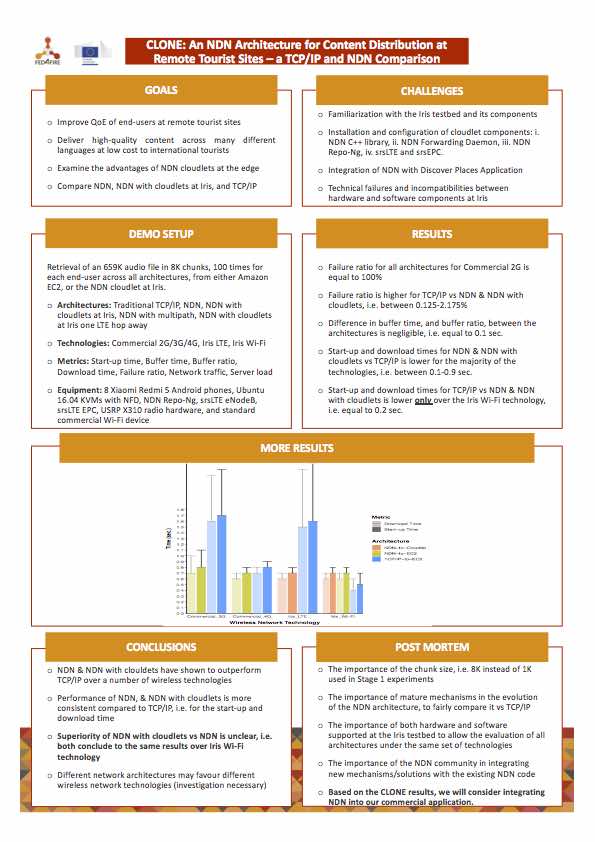BASIC INFORMATION
Short name: CLONE
Long name: CLOudlet information centric Networking Experiments
Company: Tara Hill National Park Teo
Country: Ireland
Call: F4Fp-02-Stage1 and F4Fp-02-Stage2 (see call details)
Proposal number: F4Fp-02-Stage1-04 | F4Fp-02-Stage2-04
SUMMARY REMARKS & TESTBEDS
STAGE 1
The aim of the proposed CLONE experiments is to verify and measure Key Performance Indicators (KPIs) related to content delivery supported by open source Named Data Networking (NDN) Future Internet architecture cache “cloudlets” combined with Tara Hill National Park’s (THNPs) proprietary software Android application called Discover Places. The CLONE architecture offers a potential solution to one of the main obstacles to the future development of the Discover Places application, which is the frequency of buffering interruptions and application latency related to insufficient 3G and 4G mobile network coverage in tourist areas to support real-time updates. NDN cloudlets are small cache repositories hosting named content located at the edge of the Internet close to end-users that offer efficient content delivery. This proposal defines a set of experiments that measure KPIs from these NDN cache cloudlets supported by different future Internet and wireless technologies such as NDN, cloudlets, Software Defined Networking (SDN), LTE, Wi-Fi, and hybrid LTE Wi-Fi. The expected results from experiments performed will give Tara Hill National Park Teo a deeper understanding of NDNs potential within the tourist content deliver industry at remote locations. It is expected that conclusions drawn from the experiments performed will have a long-term impact on Discover Places application development, supporting the company’s long-term competitive market advantage.
STAGE 2
The aim of the proposed CLONE experiments is to verify and measure Key Performance Indicators (KPIs) related to content delivery supported by open source Named Data Networking (NDN) Future Internet architecture cache “cloudlets” combined with Tara Hill National Park’s (THNPs) proprietary Android application called Discover Places. The CLONE architecture offers a potential solution to one of the main obstacles for the development of the Discover Places application, which is the frequency of buffering interruptions and application latency related to insufficient 3G and 4G mobile network coverage at remote tourist sites to support the delivery of high quality content. NDN cloudlets are small cache repositories hosting named chunks of content located at the edge of the Internet, close to end-users. This report describes results fromStage1 feasibility tests and defines a set of Stage 2 experiments that aim to measure KPIs related to content delivery using5G technologies. Based on the results collected inStage1, we are confident Stage 2 experiments will validate our premise that the CLONE architecture is efficient, and that it can offer a mechanism to support the delivery of low-cost and high quality content to national and international tourists at isolated locations. Stage 2 will support the development and integration of the Discover Places Android application with an optimised NFD on Android extension for content delivery developed during CLONE Stage1. Results from Stage2 experiments will give TaraHill National Park Teo a deeper understanding of NDNs potential for content deliver at remote locations.Furthermore, we can evaluate the architectures potential to support transmission of data streams over multipath wireless links(when available)to achieve higher throughput. It is expected that conclusions drawn from the experiments performed will have a long-term impact on the Discover Places application, supporting the company’s long-term competitive market advantage.
MATERIALS
- CLONE: An NDN Architecture for Content Distribution at Remote Tourist Sites – a TCP/IP and NDN Comparison – ACM
(download the paper) - CLONE: An NDN Architecture for Content Distribution at Remote Tourist Sites – a TCP/IP and NDN Comparison – ICN18
(download the paper)
- Review Open Call 2 | CLONE experiment | FEC4
(download the slides)







